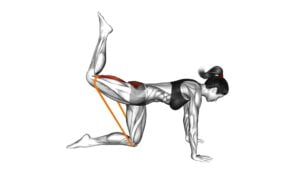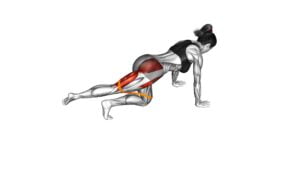Resistance Band Kneeling Back Kick (female) – Video Exercise Guide & Tips

Are you looking for an effective exercise to tone and strengthen your glutes and hamstrings? Look no further than the resistance band kneeling back kick.
Watch This Exercise Video
This simple yet powerful movement targets those hard-to-reach muscles, helping you achieve a sculpted lower body.
In this video exercise guide, we'll show you the proper form and technique, as well as provide tips and modifications to ensure you get the most out of your workout.
Get ready to feel the burn and see amazing results!
Key Takeaways
- The Resistance Band Kneeling Back Kick targets the glutes and hamstrings, improving lower body strength and preventing back pain.
- Proper form and technique, including maintaining a straight back and avoiding common mistakes, are important for injury prevention.
- Choosing the right resistance band involves considering frequency of use, different types available, appropriate resistance level, and high-quality and durable bands.
- Modifications and progressions for the exercise include increasing band tension, adding ankle weights, focusing on controlled movements, and maintaining a straight back throughout.
Proper Form and Technique
To perform the Resistance Band Kneeling Back Kick exercise correctly, you should position yourself on your hands and knees with a resistance band securely wrapped around the bottom of your foot. This exercise is a great way to target your glutes and hamstrings while also improving your balance and stability.
When performing this exercise, it's important to avoid common mistakes that can lead to injuries. One common mistake is using too much tension in the resistance band. While it's important to challenge yourself, using too much tension can put excessive strain on your muscles and joints, increasing the risk of injury. Start with a lighter resistance band and gradually increase the tension as you get stronger.
Another common mistake isn't maintaining proper form throughout the exercise. It's important to keep your core engaged and your back straight. Avoid arching your back or rounding your shoulders as this can put unnecessary stress on your spine. Focus on keeping your movements controlled and smooth.
Benefits of the Resistance Band Kneeling Back Kick
One major benefit of the Resistance Band Kneeling Back Kick exercise is that it targets your glutes and hamstrings, helping to strengthen and tone these muscle groups. By performing this exercise regularly, you can significantly improve your lower body strength. Strong glutes and hamstrings are essential for various activities such as walking, running, and lifting.
Additionally, the Resistance Band Kneeling Back Kick exercise can help prevent back pain. Strengthening the glutes and hamstrings can provide better support for the spine, reducing the risk of strain and injury. When these muscles are weak, the lower back often compensates, leading to discomfort and pain. By incorporating this exercise into your routine, you can build a strong foundation and protect your back from unnecessary stress.
Not only does this exercise provide physical benefits, but it can also have a positive impact on your overall well-being. Strengthening your lower body can improve your posture, balance, and stability. It can boost your confidence and make everyday activities easier to perform.
Remember to always maintain proper form and technique when performing the Resistance Band Kneeling Back Kick exercise. Start with a light resistance band and gradually increase the intensity as you become stronger. With consistency and dedication, you can reap the many benefits this exercise has to offer.
How to Choose the Right Resistance Band
To ensure you select the appropriate resistance band, it's important to consider the frequency with which you'll be using it. Resistance band exercises are a great way to add variety and challenge to your workout routine. They help build strength, improve flexibility, and increase muscle endurance.
When choosing a resistance band, there are a few factors to keep in mind. First, consider the different types of resistance bands available. There are loop bands, tube bands, and therapy bands, each with their own unique characteristics. Loop bands are great for lower body exercises like squats and lunges, while tube bands are versatile and can be used for both upper and lower body exercises. Therapy bands are typically used for rehabilitation purposes.
Next, consider the resistance level of the band. Bands come in different colors, each representing a different level of resistance. It's important to choose a band that challenges you without causing strain or discomfort.
Lastly, consider the quality and durability of the band. Look for bands made from high-quality materials that won't snap or break easily. Remember, choosing the right resistance band is crucial for getting the most out of your workouts and achieving your fitness goals. So take the time to select the band that suits your needs and get ready to take your workouts to the next level.
Modifications and Progressions
You can easily modify and progress the Resistance Band Kneeling Back Kick exercise by gradually increasing the resistance band's tension and frequency of use. Here are some modifications and variations you can try to enhance your workout:
- Increase the resistance band tension: Choose a band with higher resistance to make the exercise more challenging.
- Add ankle weights: Incorporating ankle weights can further increase the resistance and intensity of the movement.
To ensure you get the most out of your workout, it's important to be aware of some common mistakes:
- Using too much momentum: Avoid swinging your leg or relying on momentum to perform the kick. Instead, focus on controlled movements to engage the targeted muscles effectively.
- Arching your back: Keep your back straight throughout the exercise to maintain proper form and prevent strain on your lower back.
Tips for Getting the Most Out of Your Workout
To optimize your workout, focus on maintaining proper form and engaging the targeted muscles effectively while performing the Resistance Band Kneeling Back Kick exercise.
To start off, it's crucial to incorporate effective warm-up exercises into your routine. This helps to prepare your muscles for the upcoming workout, increase blood flow, and reduce the risk of injury. Consider incorporating dynamic stretches and light cardio exercises such as jumping jacks or jogging in place.
Additionally, it's important to prioritize rest and recovery. While it may be tempting to push yourself to the limit every day, giving your body time to rest and recover is essential for muscle growth and overall progress. Make sure to schedule rest days in your workout routine and listen to your body's signals. If you're feeling fatigued or sore, take a break and allow your muscles to recover.
Remember, quality over quantity is key. Instead of rushing through your workout, focus on performing each exercise with proper form and control. This ensures that you're effectively targeting the intended muscles and reducing the risk of injury. Engaging your core and maintaining a neutral spine throughout the Resistance Band Kneeling Back Kick exercise will maximize its effectiveness.
Frequently Asked Questions
What Is the Recommended Duration and Frequency for Performing the Resistance Band Kneeling Back Kick Exercise?
To get the most out of the resistance band kneeling back kick exercise, you should aim for a recommended duration of 10-15 minutes per session. As for frequency, it's best to perform this exercise 2-3 times a week. This will give your muscles enough time to recover and grow stronger.
Remember, consistency is key! If you're looking for modifications or variations, try adjusting the resistance of the band or experimenting with different leg positions to target different muscles.
Keep pushing yourself and you'll see progress in no time!
Can the Resistance Band Kneeling Back Kick Exercise Be Performed by Individuals With Knee or Back Injuries?
Yes, the resistance band kneeling back kick exercise can be modified for individuals with knee or back injuries. It's important to consult with a healthcare professional or physical therapist for specific modifications based on your condition.
Resistance band exercises are beneficial for knee and back rehabilitation as they help strengthen muscles, improve stability, and increase flexibility. By performing these exercises correctly and with modifications, you can work towards improving your knee and back health.
Stay motivated and focused on your rehabilitation journey!
Are There Any Specific Breathing Techniques That Should Be Followed During the Resistance Band Kneeling Back Kick Exercise?
During the resistance band kneeling back kick exercise, it's important to focus on your breathing.
By inhaling deeply through your nose before performing the kick and exhaling forcefully through your mouth as you extend your leg, you can engage your core and maximize the effectiveness of the movement.
Proper breathing techniques not only help you maintain control and stability throughout the exercise but also enhance the benefits of the resistance band kneeling back kick for improving posture and relieving lower back pain.
Can the Resistance Band Kneeling Back Kick Exercise Help Improve Posture or Alleviate Lower Back Pain?
The resistance band kneeling back kick exercise can be beneficial for improving posture and relieving lower back pain. By engaging the muscles in your back and core, this exercise helps to strengthen and stabilize your spine. It also promotes proper alignment, which can alleviate strain on your lower back and improve overall posture.
Incorporating this exercise into your routine can lead to a stronger and healthier back, reducing the risk of pain and discomfort. Keep pushing yourself to achieve better posture and a pain-free lower back!
Are There Any Alternative Exercises That Can Be Incorporated Alongside the Resistance Band Kneeling Back Kick to Target the Same Muscle Groups?
Looking for alternative exercises to target the same muscle groups as the resistance band kneeling back kick? You're in luck! There are plenty of options to choose from.
Whether it's glute bridges, donkey kicks, or fire hydrants, these exercises will engage your glutes and lower back just like the resistance band kneeling back kick.
Conclusion
Incorporating the resistance band kneeling back kick into your workout routine can help you build strength in your glutes, hamstrings, and lower back.
By choosing the right resistance band and maintaining proper form, you can maximize the benefits of this exercise.
Don't forget to modify and progress as needed to challenge yourself and continue seeing progress.
With dedication and consistency, you'll be on your way to achieving your fitness goals.
Keep pushing yourself and enjoy the results!

Author
Years ago, the spark of my life’s passion ignited in my mind the moment I stepped into the local gym for the first time. The inaugural bead of perspiration, the initial endeavor, the very first surge of endorphins, and a sense of pride that washed over me post-workout marked the beginning of my deep-seated interest in strength sports, fitness, and sports nutrition. This very curiosity blossomed rapidly into a profound fascination, propelling me to earn a Master’s degree in Physical Education from the Academy of Physical Education in Krakow, followed by a Sports Manager diploma from the Jagiellonian University. My journey of growth led me to gain more specialized qualifications, such as being a certified personal trainer with a focus on sports dietetics, a lifeguard, and an instructor for wellness and corrective gymnastics. Theoretical knowledge paired seamlessly with practical experience, reinforcing my belief that the transformation of individuals under my guidance was also a reflection of my personal growth. This belief holds true even today. Each day, I strive to push the boundaries and explore new realms. These realms gently elevate me to greater heights. The unique combination of passion for my field and the continuous quest for growth fuels my drive to break new ground.







